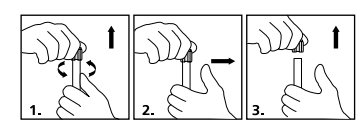TRIzol Reagent 总RNA提取试剂
| 货号 |
NBS1206-100ml |
运输温度 |
冰袋 |
| 规格 |
100ml |
保存温度 |
2-8℃保存 |
| 名称 |
总RNA提取试剂 |
有效期 |
至少一年 |
TRIzol Reagent 总RNA提取试剂
产品描述
TRIzol Reagent是一种即用型且操作迅捷的总RNA抽提试剂,适用样本广泛,包括人、动物、植物、酵母或细菌来源的细胞和组织样本。TRIzol Reagent是一种含酚、异硫氰酸胍和其他专利成分的单相溶液,有利于抽提分子量大小不一的各种RNA类型。TRIzol Reagent能够良好的维持RNA完整性,因能高效抑制样本匀浆过程中细胞破损和细胞组分溶解时释放的RNase活性。TRIzol Reagent能够同时处理大量样本,且以优化的方式一步法提取RNA,整个过程可在一小时内完成。
TRIzol Reagent分离的总RNA无蛋白质和DNA污染,适用于RT-PCR、Northern Blot、Dot Blot、poly(A)+筛选、体外翻译、RNase保护分析和分子克隆等下游实验。
保存与运输方法
保存:2-8℃保存,至少一年有效。
运输:冰袋运输。
注意事项
1) 所有离心管、枪头以及相关溶液都必须无RNase污染。对于塑料制品、玻璃和金属器皿、实验仪器等可使用固相RNase清除剂去除RNase,或者用含0.01% DEPC的去离子水浸泡过夜,之后高压灭菌、烘干。对于实验溶液可使用液相RNase清除剂来处理或用DEPC处理水来配制。
2) 对新鲜组织或细胞样本的抽提效果通常优于冻存的组织或细胞,由于组织或细胞冻融过程中可能存在一些RNase释放出来并酶切样品。若是不能及时提取RNA,推荐先加入适量TRIzol Reagent,之后裂解样品后再冻存。
3) TRIzol Reagent含有毒物质,请在操作过程中注意好防护工作,戴好手套和护眼罩,避免皮肤接触。在通风橱内完成操作,避免呼吸道吸入。
4) 为了您的安全和健康,请穿实验服并戴一次性手套操作。
使用方法
1. 需要自行准备的材料
水浴锅或微量恒温仪(Heat block)
异丙醇
75%乙醇
含0.5% SDS的RNase-free水或RNase-free水或DEPC处理水
【可选】RNase-free的糖原(核酸助沉剂)
2. 样本要求
【重要】:样本收集后立即进行RNA分离,或样本收集后立即冻存样本并保存在-80℃或液氮中直至RNA提取。
|
样本类型
|
每mlTRIzol Reagent处理的起始样本量
|
|
组织(新鲜组织或保存在RNAlater等稳定液内的组织)
|
50~100mg组织
|
|
单层生长的细胞
|
1×105~1×107单细胞层(35mm培养皿,10cm2)
|
|
悬浮生长的细胞
|
5-10×106个细胞(动植物或酵母来源)或1×107个细胞(细菌来源)
|
3. 样本准备与分相
3.1 根据起始材料用TRIzol Reagent裂解和匀浆样本。
◇组织样本
按比例每50~100mg 组织加1ml TRIzol Reagent,之后用合适的方法进行匀浆。通常用50~100mg组织即可获得足量的RNA,满足绝大多数下游实验。加入过量组织或过少TRIzol都容易导致RNA提取失败。
a)对于研钵研磨:将液氮冻存组织,放到研钵中研磨成粉末,之后加入1ml TRIzol,继续研磨至组织完全裂解【研磨要迅速,最好不要超过1min】。
b)对于玻璃匀浆器匀浆:加入1ml TRIzol上下手动匀浆组织10~15次。
c)对于机械匀浆器:将组织放入塑料管内,将塑料管置于冰浴烧杯内,加入1ml TRIzol,将分散器头垂直插入管内与组织直接接触,设置转速12,000~20,000 rpm,上下移动试管10~20次,直至组织完全打散,无明显可见大块即可。
◇单层生长的细胞
吸尽培养基,之后往35mm培养皿(10cm2)内加入1ml TRIzol Reagent,晃动3~5次,再用移液枪上下吹打3~5次,使其充分裂解。【按照10cm2培养面积加入1ml TRIzol加量。比如:六孔板每孔加入1ml TRIzol,12孔板每孔加0.5ml TRIzol】
◇ 悬浮生长的细胞
离心收集细胞,吸尽上清,每5-10×106个细胞(动植物或酵母来源)或1×107个细胞(细菌来源)加入1ml TRIzol Reagent【加入TRIzol前不要清洗细胞,否则会增加mRNA降解的可能性】。用枪吹打几次或适当涡旋,使其充分裂解。某些酵母和细菌如裂解不充分,可用匀浆器匀浆,使其完全裂解。
【注意】:样本体积不要超过加入TRIzol体积的10%。
3.2 特殊样本处理【可选】:对于某些富含蛋白,多糖或脂肪的样本,经TRIzol Reagent裂解后可能会有不溶物或油脂状漂浮物出现。此时需12,000g 4℃离心10min,之后吸取澄清的上清液至一新的离心管中。
3.3 室温孵育5min,使得核蛋白体完全分解。
3.4 按照每1ml TRIzol Reagent加入0.2ml 氯仿,盖紧盖子。涡旋混匀或用手剧烈晃动15s,室温孵育2~3min。
3.5 于12,000g 4℃离心15min。离心后混合物分为三层:下层酚–氯仿层,中间层,和上层无色的水相层。RNA无一例外的停留在水相层中。水相层的容量约为所加TRIzol Reagent体积的60%。用枪吸取上层无色水相到一新的离心管中,避免吸到任何中间层或下层成分。
【注意】:如果希望分离DNA和蛋白,请保留中间层和有机层。
4. RNA分离
4.1 RNA的沉淀:
a)【可选】如果起始样本量比较少(<106个细胞或<10mg组织),加入5-10μg RNase-free的糖原作为核酸助沉剂到水相中。
b)按每ml起初TRIzol Reagent加入0.5ml异丙醇,颠倒数次混匀,室温沉淀10min。如果希望提取microRNA等小RNA,推荐-70℃沉淀过夜。c)于12,000g 4℃离心10min,在管底可见RNA沉淀,弃上清。
4.2 RNA的清洗:
a)按每ml起初TRIzol Reagent加入1ml 75%乙醇重悬沉淀。【注:RNA在75%乙醇中-20℃至少保存1年,4℃至少1周】;
b)低速漩涡或颠倒混匀,于7,500g 4℃离心5min,弃上清。再用离心机甩一下(>5,000rpm, 离心1秒),小心吸尽液体。
c)操作的最后,简单干燥RNA沉淀(空气干燥或真空干燥5~10min)。不要在真空管里离心干燥RNA。尤为重要的是,不能让RNA沉淀完全干燥,否则会极大的降低其可溶性。部分溶解的RNA样本的A260/A280比值<1.6。
4.3 RNA的溶解:用20~50μl 无RNases水或含0.5% SDS的无RNases水溶解RNA,用枪上下吹打2~3次,使其充分溶解,置于-70℃保存或直接用于后续实验,如果后续要做酶切反应请勿用SDS。
【注意】:对于肝脏、胰腺、肾脏等RNase含量较高的组织,沉淀可用100%去离子甲酰胺溶解。
5. RNA产量的测定
5.1 用无RNase水稀释RNA,之后测定在260nm和280nm的吸收值。
5.2 使用公式A260×稀释倍数×40= μg RNA/ml。
5.3 计算A260/A280比值,比值在1.8~2.0之间视为纯度较高,浓度>4 μg/ml的样品适用于分光光度计测定。
5.4 进行甲醛变性琼脂糖电泳,确定RNA的完整性和污染情况。




